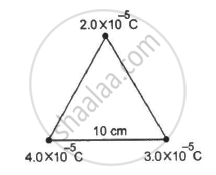Advertisements
Advertisements
प्रश्न
Write any two important points of similarities and differences each between Coulomb's law for the electrostatic field and Biot-Savart's law of the magnetic field ?
उत्तर
Following are the similarities between Coloumb's law for the electrostatic field and Biot-Savart's law of the magnetic field:
(i) Both the laws obey superposition principle.
(ii) In both the laws, the field at any point varies inversely to the square of distance from source to the point of observation. Hence, both the laws are long range.
Following are the differences between Coloumb's law for the electrostatic field and Biot-Savart's law for the magnetic field:
| Coloumb's Law for Electrostatic Field | Biot-Savart's Law for Magnetic Field |
| 1. The electrostatic field is produced by the electric charge, q, which is a scalar quantity. | The magnetic field is produced by the current element,
|
| 2. The electrostatic force acts along the line joining the source and the point, which is the displacement vector. | The magnetic field acts perpendicular to the plane containing current element
\[I {dl}^\rightharpoonup\] and displacement vector \[r^\rightharpoonup\] which is along the direction of \[(I {dl}^\rightharpoonup \times r^\rightharpoonup )\].
|
APPEARS IN
संबंधित प्रश्न
- Two insulated charged copper spheres A and B have their centers separated by a distance of 50 cm. What is the mutual force of electrostatic repulsion if the charge on each is 6.5 × 10−7 C? The radii of A and B are negligible compared to the distance of separation.
- What is the force of repulsion if each sphere is charged double the above amount, and the distance between them is halved?
Does the force on a charge due to another charge depend on the charges present nearby?
Two charged particles are placed 1.0 cm apart. What is the minimum possible magnitude of the electric force acting on each charge?
Two identical balls, each with a charge of 2.00 × 10−7 C and a mass of 100 g, are suspended from a common point by two insulating strings, each 50 cm long. The balls are held at a separation 5.0 cm apart and then released. Find.
(a) the electric force on one of the charged balls
(b) the components of the resultant force on it along and perpendicular to the string
(c) the tension in the string
(d) the acceleration of one of the balls. Answers are to be obtained only for the instant just after the release.
Two small spheres, each with a mass of 20 g, are suspended from a common point by two insulating strings of length 40 cm each. The spheres are identically charged and the separation between the balls at equilibrium is found to be 4 cm. Find the charge on each sphere.
Two identical pith balls, each carrying a charge q, are suspended from a common point by two strings of equal length l. Find the mass of each ball if the angle between the strings is 2θ in equilibrium.
A particle with a charge of 2.0 × 10−4 C is placed directly below and at a separation of 10 cm from the bob of a simple pendulum at rest. The mass of the bob is 100 g. What charge should the bob be given so that the string becomes loose?
Two equal charges, 2.0 × 10−7 C each, are held fixed at a separation of 20 cm. A third charge of equal magnitude is placed midway between the two charges. It is now moved to a point 20 cm from both the charges. How much work is done by the electric field during the process?
How much work has to be done in assembling three charged particles at the vertices of an equilateral triangle, as shown in the figure?
